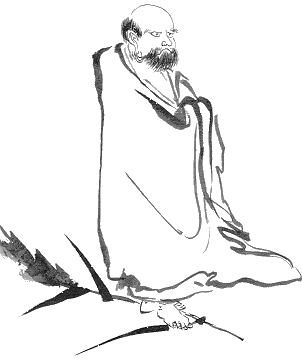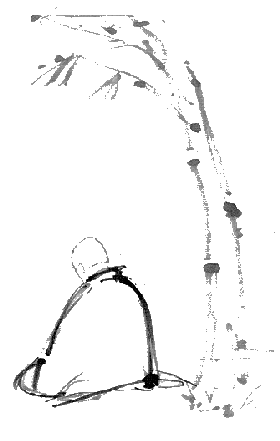 What
is Ch'an? (2) What
is Ch'an? (2)
 Ch'an
is a form of Buddhism that originated in China. It was transmitted to Japan
where it became known as Zen, the name most familiar to Westerners. The
ultimate goal of Ch'an is the realization of one's true nature and the
expression of this realization in our interactions with others. The goal
is nothing less than the attainment of our full potential as Buddhas --
the embodiment of wisdom and compassion. Ch'an
is a form of Buddhism that originated in China. It was transmitted to Japan
where it became known as Zen, the name most familiar to Westerners. The
ultimate goal of Ch'an is the realization of one's true nature and the
expression of this realization in our interactions with others. The goal
is nothing less than the attainment of our full potential as Buddhas --
the embodiment of wisdom and compassion.
The path of Ch'an meditation practice also
benefits people physically, psychologically and spiritually.
In Dharma Drum, Ch'an Master Sheng-yen
writes:
"You may have heard that Ch'an Buddhism
resembles a religion, but is not truly a religion. Ch'an Buddhism is indeed
a religion. Religion requires faith, and the practice of Ch'an cannot be
accomplished without faith. Understand, though, that the faith we speak
of in the Ch'an tradition is different from faith as it is conceived in
other religions, which emphasize belief in supernormal beings or gods distinct
from oneself. Ch'an stresses the importance of having faith in the Dharma,
or teachings of the Buddha. These teachings tell us that everyone has Buddha-nature
and that everyone can attain Buddhahood. Every human being who truly has
faith in the teachings of the Buddha and follows the principles and methods
of practice can become a Buddha.
"When we discuss the development of Ch'an
in China, we face difficulties in separating specific concepts shaping
Ch'an from those of Buddhism in general. The fact is that it is impossible
to achieve the highest attainment in Buddhism without the experience of
practice equivalent to that found in the Ch'an tradition. Buddhism emphasizes
the cultivation and realization of wisdom, which resolves internal struggles
and suffering. But how do we cultivate wisdom? We rely on the guidance
of Buddhist methods similar to those found in Ch'an practice.
"Buddhism was first brought to China about
one thousand years after Sakyamuni Buddha attained enlightenment and introduced
the world to the Dharma. During Buddhism's early period, dhyana
cultivation was set forth as the primary method of practice. Dhyana cultivation
systematically calms the mind which, in turn, catalyzes an understanding
of self that generates wisdom. The introduction of this method as an opening
to the path of wisdom was important to the transmission of Buddhism to
China.
"There are many stories in the Ch'an tradition
about disciples asking their masters the question, 'What did Boddhidharma
bring from India to China?' The answers from all the masters appear to
be different, but their essential point is the same: Bodhidharma brought
nothing to China but himself. He went to China to tell people that everyone
has Buddha-nature and that everyone can attain Buddha-hood."
...
"The Sixth Patriarch, Hui-neng (638-713),
probably contributed the most to the development of Ch'an. His teachings
can be summarized in the phrase: 'No abiding, no thought, no form.' You
must experience the state of mind to which these phrases refer, realize
the Buddha-nature in yourself, and realize as well that even though we
speak of Buddha-nature, we can point to no concrete form that gives it
shape. Buddha-nature is the essence of emptiness - sunyata."
...
"Ch'an encompasses four key concepts: faith,
understanding, practice, and realization. Faith belongs to the realm of
religion; understanding is philosophical; practice is belief put into action;
and realization is enlightenment. Without faith, we cannot understand;
without understanding, we cannot practice; and without practice, we cannot
realize enlightenment. Together, these four concepts create the doorway
we enter to attain wisdom."
...
"Ch'an practice involves meditation, which
can be an uncomfortable, physically painful process. Perhaps this is why
a few early Ch'an masters did not encourage sitting meditation. Even the
old manuscripts and documents show no evidence of the Sixth Patriarch sitting
in meditation either before or after his enlightenment."
...
 "Prior
to the Sixth Patriarch, the Third, Fourth and Fifth Patriarchs all emphasized
the practice of meditation... We may say that enlightenment does not come
from meditation, but meditating is nonetheless a necessary step toward
liberation. And Ch'an teaching should work in conjunction with meditation
practice. With the guidance of a good teacher, strong practice, and Ch'an
teachings, enlightenment is not far away. "Prior
to the Sixth Patriarch, the Third, Fourth and Fifth Patriarchs all emphasized
the practice of meditation... We may say that enlightenment does not come
from meditation, but meditating is nonetheless a necessary step toward
liberation. And Ch'an teaching should work in conjunction with meditation
practice. With the guidance of a good teacher, strong practice, and Ch'an
teachings, enlightenment is not far away.
"We can calm the mind only by using a method
of meditation. Once the mind is calm, we can reduce the subjective and
habitual patterns of self-based notions that cause so much vexation. When
we achieve a tranquil or unified state of awareness, it is possible to
see just what the self is.
"There are essentially two major schools
of Ch'an meditation: Lin-chi (Jp. Rinzai), which uses the methods of kung-an
or hua-t'ou, and Ts'ao-tung (Jp. Soto), which uses the method of silent
illumination. Using the methods of either of these schools can lead to
enlightenment, and regardless of which one you adopt, you must first be
able to relax both body and mind and then bring yourself to a concentrated,
unified state of mind. Only at this point can you use the methods of kung-an
or hua-t'ou and silent illumination.
"You cannot fulfill the process of meditation
by reading a couple of phrases in a book. Meditation involves long, sustained
practice."
Back
|
